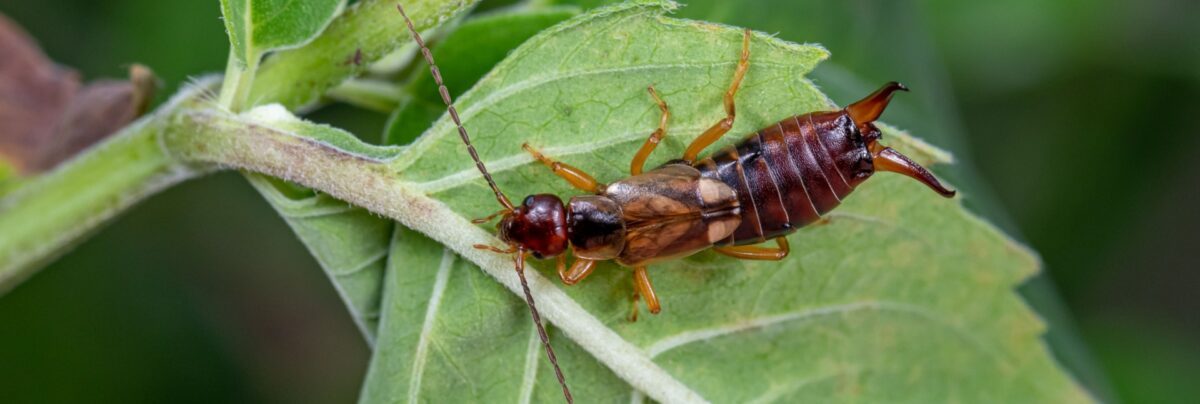Tag: Earwig Damage

If you’re a gardener or homeowner in South Carolina, you might have noticed small, ragged holes on the leaves of your outdoor plants and shrubs. These unsightly signs of damage could be caused by a common but often overlooked pest: earwigs. While earwigs generally play a beneficial role in gardens by feeding on decaying plant matter and other insects, they can sometimes turn into a nuisance by feeding on live plants.
Knowing how to identify earwig damage early is key to protecting your garden’s health and beauty. This blog will help you recognize the telltale signs of earwig feeding on your plants and shrubs and guide you on how to manage and prevent further damage. For expert assistance, Team Veterans Pest Control is here to provide professional solutions tailored to South Carolina’s unique environment.
What Is Earwig Damage?
Earwigs are small, nocturnal insects easily recognized by the pair of pincers on their rear end. They feed mostly at night, hiding during the day in moist, dark places like mulch, garden debris, or under stones. Their feeding habits can cause distinctive damage to outdoor plants and shrubs.
Earwig damage typically appears as irregular, ragged holes or notches on leaves, petals, and sometimes on young fruits. The damage can affect a wide range of plants, including vegetables, flowers, shrubs, and even some fruits.
Common Signs of Earwig Damage on Plants and Shrubs
1. Ragged or Irregular Holes in Leaves
One of the clearest signs of earwig damage is the presence of jagged, uneven holes on leaves. Unlike the smooth holes caused by some other pests, earwig feeding often looks torn or shredded. These holes may vary in size, depending on the earwig population and plant type.
2. Notched Leaf Edges
In addition to holes, earwigs frequently chew on the edges of leaves, leaving notched or scalloped margins. This damage can sometimes be mistaken for mechanical injury, but consistent notching on multiple leaves is a strong indicator of earwig activity.
3. Damage to Flowers and Petals
Earwigs also feed on tender flower petals, causing ragged edges or holes in blooms. This can reduce the aesthetic appeal of flowering plants, especially those prized for their blossoms.
4. Chewed Fruits and Vegetables
In vegetable gardens, earwigs may feed on young fruits such as strawberries or beans, leaving small holes or surface scarring. This damage can encourage rot or disease, leading to further crop loss.
5. Presence of Earwigs
While spotting the damage is important, seeing the pests themselves can confirm the problem. Earwigs are mostly active at night and can often be found hiding in moist mulch, under pots, or in plant debris during the day.
Why Is Earwig Damage a Concern?
While earwigs provide some benefits by consuming decaying organic matter and other small insects, high populations can quickly lead to extensive earwig damage. This feeding can stress plants, reduce photosynthesis by damaging leaves, and diminish the overall health and appearance of your garden.
In vegetable gardens, the damage caused by earwigs can directly affect crop yields and quality. Ornamental plants and shrubs can also suffer, impacting your landscaping’s beauty and value.
How to Manage and Prevent Earwig Damage
If you notice signs of earwig damage, it’s important to take steps to manage their population and prevent further harm to your plants. Here are some effective strategies:
1. Remove Hiding Places
Earwigs prefer moist, dark environments. Clearing away excess mulch, leaf litter, and garden debris can reduce their daytime hiding spots. Keep the garden tidy and remove objects like stones or wood piles near your plants.
2. Reduce Moisture Levels
Since earwigs thrive in damp conditions, addressing overwatering or poor drainage can make your garden less hospitable to them. Water early in the day to allow surfaces to dry and avoid excessive irrigation.
3. Use Physical Traps
You can trap earwigs by placing rolled-up damp newspapers or cardboard strips in your garden at night. Check these traps in the morning and dispose of the earwigs by dropping them into soapy water.
4. Encourage Natural Predators
Birds, frogs, toads, and beneficial insects such as ground beetles feed on earwigs. Creating a garden habitat that supports these natural predators helps maintain a healthy balance and controls earwig populations.
5. Consider Professional Pest Control
If earwig damage becomes severe or persistent, professional help may be needed. Team Veterans Pest Control specializes in pest management for South Carolina gardens and landscapes. Our experts can assess the situation and apply targeted, environmentally responsible treatments to control earwigs and protect your plants.
Why Choose Team Veterans Pest Control?
With extensive experience serving South Carolina homeowners, Team Veterans Pest Control understands the local pest challenges. Our skilled technicians use proven techniques and safe products to manage earwigs and other common garden pests effectively. We offer personalized service plans that include thorough inspections, treatment, and ongoing monitoring to keep your outdoor spaces healthy and beautiful year-round.